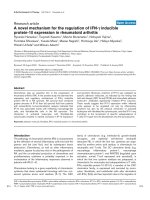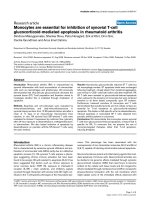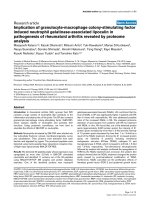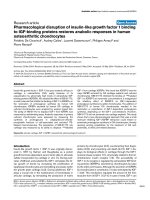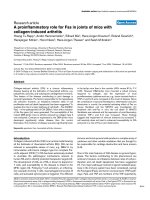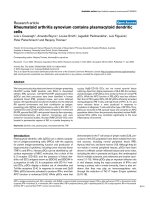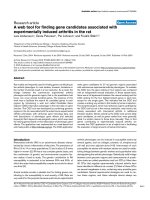Báo cáo y học: "Rheumatoid arthritis seropositive for the rheumatoid factor is linked to the protein tyrosine phosphatase nonreceptor 22-620W allele" docx
Bạn đang xem bản rút gọn của tài liệu. Xem và tải ngay bản đầy đủ của tài liệu tại đây (175.25 KB, 8 trang )
Open Access
Available online />R1200
Vol 7 No 6
Research article
Rheumatoid arthritis seropositive for the rheumatoid factor is
linked to the protein tyrosine phosphatase nonreceptor 22-620W
allele
Philippe Dieudé
1,2
, Sophie Garnier
1
, Laëtitia Michou
1
, Elisabeth Petit-Teixeira
1
, Elodie Glikmans
1
,
Céline Pierlot
1
, Sandra Lasbleiz
1,2
, Thomas Bardin
1,2
, Bernard Prum
3
, François Cornélis
1,2,4
for the
European Consortium on Rheumatoid Arthritis Families
1
GenHotel-EA3886, Evry-Genopole, Evry, France
2
Unité de Génétique Clinique, Fédération de Rhumatologie, Centre Viggo-Petersen, Hôpital Lariboisière, Assistance Publique des Hôpitaux de Paris,
Paris, France
3
Laboratoire Statistique et Génome, Evry-Genopole, Evry, France
4
Consultation de Génétique Adulte, Centre Hospitalier Sud-Francilien, Evry-Corbeil, France
Corresponding author: Philippe Dieudé,
Received: 14 May 2005 Revisions requested: 21 Jun 2005 Revisions received: 15 Jul 2005 Accepted: 4 Aug 2005 Published: 25 Aug 2005
Arthritis Research & Therapy 2005, 7:R1200-R1207 (DOI 10.1186/ar1812)
This article is online at: />© 2005 Dieudé et al.; licensee BioMed Central Ltd.
This is an Open Access article distributed under the terms of the Creative Commons Attribution License ( />2.0), which permits unrestricted use, distribution, and reproduction in any medium, provided the original work is properly cited.
Abstract
The protein tyrosine phosphatase nonreceptor type 22
(PTPN22) gene encodes for lymphoid tyrosine phosphatase
LYP, involved in the negative regulation of early T-cell activation.
An association has recently been reported between the
PTPN22-620W functional allele and rheumatoid factor-positive
(RF
+
) rheumatoid arthritis (RA), among other autoimmune
diseases. Expected linkage proof for consistency cannot be
definitely produced by an affected sib-pair (ASP) analysis. Our
aim was therefore to search for linkage evidence with the
transmission disequilibrium test.
DNA from the French Caucasian population was available for
two samples of 100 families with one RA patient and both
parents, and for 88 RA index cases from RA ASP families.
Genotyping was carried out by PCR-restriction fragment length
polymorphism. The analysis was performed using the
transmission disequilibrium test, genotype relative risk and ASP-
based analysis.
The transmission disequilibrium test of the PTPN22-620W
allele revealed linkage and association for RF
+
RA (61% of
transmission, P = 0.037). The genotype relative risk showed the
risk allele in 34% of RF
+
RA patients and in 24% of controls
derived from nontransmitted parental chromosomes (P = 0.047,
odds ratio = 1.69, 95% confidence interval = 1.03–2.78). The
ASP investigation showed no enriched risk allele in RA multiplex
families, resulting in a lack of power of ASP analysis, explaining
the published negative results.
This study is the first to show linkage of PTPN22 to RF
+
RA,
consistent with PTPN22 as a new RA gene.
Introduction
Rheumatoid arthritis (RA), the most common autoimmune dis-
ease, is thought to be a complex disease in which a combina-
tion of risk alleles from different susceptibility genes
predisposes to the development of the disease, following
exposure to as yet unknown environmental factors. Several
genome scans have suggested multiple RA loci [1-8], and
recent case-control association studies have suggested new
RA genes [9,10]. However, only HLA-DRB1 alleles have been
both linked to and associated with RA, fulfilling the criteria for
a fully demonstrated genetic factor [11].
A genetic association involving a functional polymorphism of
the protein tyrosine phosphatase nonreceptor type 22
(PTPN22) gene was reported to be associated with rheuma-
toid factor-positive (RF
+
) RA, with type 1 diabetes, with
ASP = affected sib-pair; GRR = genotype relative risk; PCR = polymerase chain reaction; RA = rheumatoid arthritis; RF = rheumatoid factor; SNP =
single nucleotide polymorphism; TDT = transmission disequilibrium test.
Arthritis Research & Therapy Vol 7 No 6 Dieudé et al.
R1201
systemic lupus erythematosus and with autoimmune thyroid
disease [12-19]. The PTPN22 gene encodes for the intracel-
lular tyrosine phosphatase LYP, which acts as a negative reg-
ulator of early T-cell activation through binding to the Csk
protein [20,21].
The PTPN22 single nucleotide polymorphism (SNP) (1858C/
T) (rs 2476601) occurs as a result of an amino acid substitu-
tion of arginine for tryptophan at position 620 (R620W), in the
P1 proline-rich domain. This domain is involved in the binding
to the SH3 domain of Csk. Functional analysis showed that it
affects the binding of LYP to Csk, leading to a lack of down-
regulation of T-cell activation, which is consistent with an
increased susceptibility to autoimmunity for the 620W allele
[12,14].
The PTPN22-1858T allele has been reported to be associ-
ated with RF
+
RA in several case-control studies
[12,18,19,22]. The first study, performed in a white North
American population, reported an association between the
PTPN22-1858T allele and RF
+
sporadic RA (P = 6.6 × 10
-4
).
This association was replicated in a different sample with mul-
tiplex RA cases (P = 5.6 × 10
-8
), the association being
restricted to RF
+
RA patients [12]. The second study, also per-
formed in a white North American population, compared the
frequency of the PTPN22 risk allele between the Study of New
Onset Rheumatoid Arthritis cohort and the control sample of
the previous study [12], observing the association between
the 1858T allele and early RF
+
RA. The study also suggested
a stronger association for the homozygous genotype 1858T/T
[22]. Three recent case-control studies performed in UK,
Spanish and North-American Caucasian populations also
found an association between the PTPN22-1858T allele and
RA [18,19,23]. In contrast, the Spanish study observed no
dose effect of the suspected allele [18]. The UK study found
an increased frequency of the suspected PTPN22 allele in the
RF
+
RA cases and suggested a stronger association for the
homozygous genotype [19]. The US study confirmed this
association was restricted to RF
+
RA and also showed a sig-
nificantly higher risk for the homozygous genotype [23].
These findings provide strong evidence for the involvement of
PTPN22 in RF
+
RA susceptibility [24]. The linkage proof is so
far lacking, however, as the linkage analysis of the North Amer-
ican Rheumatoid Arthritis Consortium RA-affected sib-pairs
resource for this PTPN22 SNP was inconclusive [12]. The
transmission disequilibrium test (TDT), simultaneously investi-
gating linkage and association, is predicted to be more pow-
erful than the affected sib-pair (ASP) analysis in demonstrating
linkage for a factor such as PTPN22 [25,26]. Three family-
based association and linkage studies using TDT analysis
were recently reported, providing linkage evidence of PTPN22
to type 1 diabetes [15,27,28]. The aim of the present study
was to test this PTPN22 polymorphism for linkage to RF
+
RA
in the French Caucasian population, taking advantage of the
TDT.
Patients and methods
Study design and study population
A TDT linkage study was conducted to investigate the
PTPN22-1858C/T SNP in RA for one Caucasian population.
RA patients and family members were recruited through a
national media campaign in France, which was followed by the
selection of individuals who fulfill the American College of
Rheumatology (formerly the American Rheumatism Associa-
tion) 1987 revised criteria for RA [29], according to the physi-
cian in charge of the patient. All clinical data were reviewed by
rheumatologists from our team (SL, LM or P Fritz). All individu-
als provided informed consent and the ethics committee of the
Hôpital Bicêtre approved the study.
Transmission disequilibrium test RA samples
Inclusion criteria for the two samples of the 100 French Cau-
casian families investigated here were the participation of one
RA patient and both parents, as well as a French Caucasian
origin of the family, defined by the four grandparents being
French Caucasian. Families with an additional sibling with RA
or RA patients who were younger than 18 years old were
excluded. RA characteristics of index cases from TDT samples
1 and 2 are summarized in Table 1.
Affected sib-pair RA sample
The 88 index RA patients from the French Caucasian ASP
families that had been analyzed for a refined genome scan
were investigated in this study [1]. Inclusion criteria for the
sample of 88 families had been the participation of at least two
siblings with RA and of French Caucasian origin, with all four
grandparents being of European Caucasian origin. Families
with RA patients younger than 18 years old were excluded. Of
these 88 families, 81 had two affected siblings, six families had
three affected siblings and one family had four affected sib-
lings. Characteristics of the 88 RA index cases investigated in
this study are summarized in Table 1. All ASP families had
been previously genotyped for two microsatellite markers
flanking the PTPN22 locus (D1S418 and D1S252) located at
approximately -1 and +3 Mb, respectively, on either side of the
PTPN22 locus, with heterozygosities of 80% and 81%,
respectively [1,30].
Molecular genotyping methods
Genomic DNA was purified from fresh peripheral blood leuko-
cytes by standard methods [31]. HLA-DRB1 typing (Dynal
Classic high resolution and Sequence Specific Primers DR
low resolution) and subtyping (Dynal Classic high resolution,
for HLA-DRB1*01, HLA-DRB1*04, HLA-DRB1*11 and HLA-
DRB1*13) were carried out using the PCR sequence-specific
primers method (Dynal Biotech, Lake Success, NY, USA).
Available online />R1202
Genotyping of the PTPN22-1858C/T SNP was performed by
PCR-restriction fragment length polymorphism. The sense and
antisense primers were, respectively, 5'-GATAATGTTGCT-
TCAACGGAATTT-3' and 5'-CCATCCCACACTTTATTT-
TATACT-3'. The PTPN22-1858C/T transition at codon 620
eliminates a restriction site for RsAI in the 1858T allele. TDT
RA sample 1 and sample 2 genotypes were checked with the
PCR-restriction fragment length polymorphism using the XcmI
enzyme, for which the 1858T allele creates a restriction site.
Each genotype was interpreted independently by two of the
investigators (EG and PD).
Rheumatoid factor status
The RF
+
status was provided by the presence of at least one
positive RF
+
result during the disease course, as determined
by latex fixation, by Waaler Rose assay or by laser nephelom-
etry. The RF test was performed at least once for all TDT and
ASP RA patients. The anti-cyclic citrullinated peptide status of
RA patients was not available.
Hardy–Weinberg equilibrium check
The Hardy–Weinberg equilibrium of the PTPN22-1858C/T
polymorphism was investigated using a chi-square test with
one degree of freedom.
Analysis
We planned a linkage test of the PTPN22-1858T allele RA
hypothesis, restricted to RF
+
RA patients. This hypothesis was
first tested using the TDT RA sample 1. In case linkage was
observed, or at least suggested, a replication test was planned
with the TDT RA sample 2 and a global analysis for all TDT RA
families. We also investigated the PTPN22 putative genotype
in the index ASP RA sample, taking advantage of the linkage
data available at the PTPN22 locus, as previously described
[32].
Test for linkage and association in the TDT RA samples
Linkage and association analysis were performed using the
TDT [33] and the genotype relative risk (GRR) test [34]. The
TDT compares the transmission of the SNP alleles from heter-
ozygous parents to affected offspring, with Mendel's law
expectation (50%), using a chi-square test with one degree of
freedom. Similar to a case–control study, GRR compares the
SNP genotypes distribution in RA cases and in 'controls' (con-
trols are derived from nontransmitted parental chromosomes,
for each family), using a chi-square test with the appropriate
degree of freedom or the Fisher's exact test. P < 0.05 was
considered significant.
Linkage-based test in the ASP RA sample [32]
Genetic factors are expected to be concentrated in families
with multiples RA cases, such as ASP families. Within index
RA cases, those sharing identical by descent chromosomes at
the PTPN22 locus with their RA affected sib could be
expected to concentrate further PTPN22 RA genetic factors.
The putative PTPN22 genotypes were compared between the
ASP RA index cases, the TDT RA cases and the controls from
the TDT RA samples (controls are derived from nontransmit-
ted parental chromosomes). For the linkage-based association
test, the RF
+
index cases that shared at least one allele identi-
cal by descent with their RF
+
RA sib (IBD1 or IBD2) were
used, taking advantage of the linkage data available at the
PTPN22 locus [32].
Stratified linkage analysis based on the PTPN22-1858C/T
genotypes
We conducted a linkage analysis using Allegro 1.1 software
[35], taking into account the PTPN22-1858C/T genotypes, to
select the subgroup of families with an index carrying the puta-
tive genotypes.
Power calculation
Assuming a PTPN22-1858T allele association similar to that
of the North American population (14.8% allele frequency in
RF
+
RA cases and 8.7% in controls) [12], association analysis
of our 100 TDT families (TDT RA sample 1) provides a 95%
power to show a suggestion for association and a 53% power
Table 1
Characteristics of rheumatoid arthritis (RA) index cases from the investigated samples
TDT RA sample 1 (n = 100) TDT RA sample 2 (n = 100) ASP RA sample (n = 88)
Female (%) 87 90 84
Mean age (± standard deviation) at disease onset
(years)
32 (± 10) 31 (± 6) 40 (± 14)
Mean (± standard deviation) disease duration (years) 18 (± 7) 16 (± 8) 23 (± 10)
RA patients with bone erosions (%) 90 79 80
RA patients seropositive for rheumatoid factor (%) 81 76 84
RA patients carrying at least one HLA-DRB1 shared
epitope allele
a
(%)
78 80 77
TDT, transmission disequilibrium test; ASP, affected sib-pair
a
DRB1*0101, DRB1*0102, DRB1*0401, DRB1*0404, DRB1*0405, DRB1*0408, DRB1*1001.
Arthritis Research & Therapy Vol 7 No 6 Dieudé et al.
R1203
to reach statistical significance (P < 0.05). Our sample of 200
TDT families provides a 79% power for significance.
Results
Hardy–Weinberg equilibrium check
The PTPN22-1858C/T polymorphism was in Hardy-Wein-
berg equilibrium in the control samples investigated.
Test for linkage and association in the TDT RA samples
TDT RA sample 1
The PTPN22-1858T allele was more frequent in the RF
+
RA
cases than in the controls: 20% versus 11% (P = 0.022, odds
ratio [OR] = 2.05, 95% confidence interval [CI] = 1.1–3.8).
The allele frequency observed in rheumatoid factor-negative
(RF
-
) RA patients was 16%, compared with 10.5% in the
resulting controls (P = 0.52). Significant linkage to RF
+
RA
was observed with an excess of transmission of the 1858T
allele from heterozygous parents to RA cases (66% versus
50%, n = 47, P = 0.029) (Table 2). The GRR analysis revealed
a statistically significant increase in the frequency of geno-
types carrying the PTPN22-1858T allele (1858C/T + 1858T/
T) in RF
+
RA cases (35%) compared with controls (21%)
(Table 3).
TDT RA sample 2
We observed an excess of transmission of the PTPN22-
1858T allele to RF
+
RA patients that was not significant (56%,
P = 0.45) (Table 2). The GRR analysis showed a nonsignifi-
cant increase of the genotypes carrying the 1858T allele in
RF
+
RA patients compared with controls (Table 3).
Combined analysis of TDT samples
No statistically significant difference was observed between
samples 1 and 2, allowing pooling for combined analysis.
PTPN22 linkage to RF
+
RA was significant (T-allele transmis-
sion, 61%; n = 90, P = 0.037). By contrast, transmission to
RF
-
RA followed Mendel's law exactly (50%) (Table 2). The
PTPN22-1858T allele frequency was significantly increased
in RF
+
RA compared with controls (19% versus 13%, P =
0.029, OR = 1.62, 95% CI = 1.05–2.50). The GRR analysis
showed a significant increase of PTPN22 genotypes carrying
the PTPN22-1858T allele in RF
+
RA patients compared with
controls (34% versus 24%, P = 0.047, OR = 1.69, 95% CI =
1.03–2.78). In the RF
-
RA patients, genotype frequencies
were identical to those of controls, in keeping with the 50%
transmission (Table 3).
No correlation between the HLA-DRB1 shared epitope status
(DRB1*0101, DRB1*0102, DRB1*0401, DRB1*0404,
DRB1*0405, DRB1*0408, DRB1*1001) and the PTPN22
genotypes in RF
+
RA index cases was observed (Table 4).
Apart from the RF status, no specific clinical features (erosive
disease, age at disease onset) were found to be associated
with the PTPN22-1858T/C or PTPN22-1858T/T genotypes
(data not shown).
Linkage-based test in the RA multiplex ASP sample
The frequency of the PTPN22-1858T allele was similar in the
RF
+
ASP RA cases compared with the RF
+
TDT RA cases
(18% versus 19%). The linkage-based subgroup (IBD1 or
IBD2) of RF
+
RA index cases with concordant RF
+
RA sibs
showed no increase in the frequency of the suspected allele,
Table 2
Linkage analysis of the PTPN22-1858T allele to rheumatoid factor-seropositive (RF
+
) rheumatoid arthritis (RA) using the
transmission disequilibrium test (TDT)
Families Transmission [% (n)] P
TDT RA sample 1
TDT RA index cases (n = 100) 66 (55) 0.022
TDT RA index cases RF
+
(n = 81) 66 (47) 0.029
TDT RA index cases RF
-
(n = 19) 63 (8) 0.48
TDT RA sample 2
TDT RA index cases (n = 100) 53 (57) 0.69
TDT RA index cases RF
+
(n = 76) 56 (43) 0.45
TDT RA index cases RF
-
(n = 24) 43 (14) 0.59
All TDT RA families
All TDT RA index cases (n = 200) 59 (112) 0.059
All TDT RA index cases RF
+
(n = 157) 61 (90) 0.037
All TDT RA index cases RF
-
(n = 43) 50 (22) 1
RF
-
, seronegative for rheumatoid factor. Transmission, percentage of heterozygous 1858C/T parents transmitting the 1858T allele. The plan was
to test the hypothesis for RF
+
RA; analysis for all RA and RF
-
RA were provided for the discussion.
Available online />R1204
compared with RF
+
TDT RA cases. The GRR analysis was
consistent with those findings, the PTPN22-1858C/T or
PTPN22-1858T/T genotype frequency being equal between
RF
+
RA ASP index cases and RF
+
RA TDT cases (Table 5).
Stratified linkage analysis at the PTPN22 locus based on
the 1858C/T genotypes
Previous linkage analysis of these ASP families had shown no
linkage at the PTPN22 locus (P = 0.74) [1]. Stratified linkage
analysis in RF
+
-concordant ASP, even after selection of the
families with index cases carrying the PTPN22-1858C/T or
PTPN22-1858T/T genotypes, still showed no linkage evi-
dence at the PTPN22 locus (P = 0.69).
Discussion
We searched for the PTPN22-1858T allele linkage to RF
+
RA
using the TDT, which simultaneously tests linkage and associ-
ation, avoiding the major drawback of inevitable imperfect
matching between cases and controls. Here, we provide
linkage evidence for RF
+
RA to the PTPN22-1858T allele. We
also observed association with the PTPN22-1858C/T or
PTPN22-1858T/T genotypes and we report for the first time
an estimation of the association in the French Caucasian pop-
ulation for RF
+
RA (34% versus 24%, P = 0.047, OR = 1.69,
95% CI = 1.03–2.78). In ASP RF
+
RA index cases, the
1858C/T or 1858T/T genotype has a similar frequency as the
TDT RF
+
RA index cases. The association appears to be inde-
pendent from the HLA-DRB1 shared epitope.
Our findings therefore provide linkage evidence in support of
PTPN22 as a new RF
+
RA genetic factor, concurring with pre-
viously reported case–control studies [12,18,19,22,23]. We
extend this observation to the French Caucasian population, in
which the magnitude of the association is similar.
Table 3
Association of PTPN22 genotypes carrying the 1858T allele and rheumatoid factor-seropositive (RF
+
) rheumatoid arthritis (RA)
PTPN22 genotypes [% (n)] P
a
Odds ratio (95% confidence interval)
C/C C/T T/T C/T or T/T
TDT RA sample 1
All TDT RA index cases (n = 100) 65 (65) 31 (31) 4 (4) 35 (35)
Controls
b
(n = 100) 79 (79) 20 (20) 1 (1) 21 (21) 0.029 2.05 (1.07–3.81)
TDT RA index cases RF
+
(n = 81) 64 (52) 31 (25) 5 (4) 36 (29)
Controls
b
(n = 81) 79 (64) 20 (16) 1 (1) 21 (17) 0.038 2.1 (1.04–4.24)
TDT RA index cases RF
-
(n = 19) 68 (13) 32 (6) 0 32 (6)
Controls
b
(n = 19) 79 (15) 21 (4) 0 21 (4) 0.71
TDT RA sample 2
All TDT RA index cases (n = 100) 69 (69) 27 (27) 4 (4) 31 (31) 0.76
Controls
b
(n = 100) 71 (71) 26 (26) 3 (3) 29 (29)
TDT RA index cases RF
+
(n = 76) 68 (52) 28 (21) 4 (3) 32 (24)
Controls
b
(n = 76) 74 (56) 24 (18) 2 (2) 26 (20) 0.47
TDT RA index cases RF
-
(n = 24) 71 (17) 25 (6) 4 (1) 29 (7)
Controls
b
(n = 24) 63 (15) 33 (8) 4 (1) 37 (9) 0.76
All TDT RA families
All TDT RA index cases (n = 200) 67 (134) 29 (58) 4 (8) 33 (66)
Controls
b
(n = 200) 75 (150) 23 (46) 2 (4) 25 (50) 0.078
TDT RA index cases RF
+
(n = 157) 66 (104) 29 (46) 5 (7) 34 (53)
Controls
b
(n = 157) 76 (120) 22 (34) 2 (3) 24 (37) 0.047 1.69 (1.03–2.78)
TDT RA index cases RF
-
(n = 43) 70 (30) 28 (12) 2 (1) 30 (13)
Controls
b
(n = 43) 70 (30) 28 (12) 2 (1) 30 (13) 1
RF
-
, seronegative for rheumatoid factor.
a
Following data previously reported in RA and because of the infrequency of the PTPN22-1858T/T genotype, it was combined with the 1858C/T
genotype for the analysis.
b
Controls derived from nontransmitted parental chromosomes.
Arthritis Research & Therapy Vol 7 No 6 Dieudé et al.
R1205
The linkage evidence provided by this study remains statisti-
cally modest. Further linkage studies are needed to definitively
establish linkage of the PTPN22-1858T allele to RF
+
RA. For
the observed transmission disequilibrium of 61%, a TDT sam-
ple size of 232 families would be required to obtain, with 80%
power, an independent replication of the linkage evidence
reported here.
Genome scans are popular as they do not require any a priori
hypothesis to detect disease loci. They are clearly unable to
detect all disease loci, however, especially factors such as
PTPN22. The increased power of the TDT over the ASP anal-
ysis for such factors was predicted long ago [26]. Our obser-
vation of the absence of a major increased frequency of the
risk allele in multiplex ASP families when compared with spo-
radic cases, as reported by Begovich and colleagues [12],
allows us to estimate the excess of allele sharing expected in
the ASP analysis over the Mendel expectation of 50%. Using
the estimation of the divergence from Mendel's law obtained
from this study (61% transmission from heterozygous parents
to RF
+
RA patients, instead of 50%) and the genotype fre-
quencies observed, the allele sharing expected is 52% for all
families, 53% for the subgroup of RF
+
-concordant families and
56% for the small subgroup of RF
+
-concordant families with
the 1858C/T or 1858T/T index case.
A huge sample size would therefore be required to demon-
strate a significant excess of allele sharing over Mendel's law.
In that regard, the PTPN22 situation is similar to that of the
insulin gene in type 1 diabetes, for which the discrepancy
between numerous association reports and the absence of
linkage in ASP analysis was resolved using a TDT-like analysis
[36]. This explains the complete absence of linkage evidence
that we observed in our ASP analysis, in keeping with the
Table 4
PTPN22-1858 C/T genotypes distribution according to the HLA-DRB1 shared epitope (SE)
PTPN22 C/T or T/T PTPN22 C/C P
TDT RA sample 1 0.88
HLA-DRB1*SE/SE 10 16
HLA-DRB1*SE/X 18 34
HLA-DRB1*X/X 715
TDT RA sample 2 0.16
HLA-DRB1*SE/SE 13 17
HLA-DRB1*SE/X 14 35
HLA-DRB1*X/X 417
All TDT RA families 0.25
HLA-DRB1*SE/SE 23 33
HLA-DRB1*SE/X 32 69
HLA-DRB1*X/X 11 32
HLA-DRB1*SE/SE, two shared epitopes; HLA-DRB1*SE/X, one shared epitope; HLA-DRB1*X/X, zero shared epitope.
Table 5
PTPN22-1858C/T genotypes frequencies in the affected sib-pair (ASP) rheumatoid arthritis (RA) sample
PTPN22-1858C/T genotype frequencies [% (n)] P
a
C/C C/T T/T C/T or T/T
ASP RA index cases RF
+
(n = 74) versus controls
b
(n = 200) 66 (49) 31 (23) 3 (2) 34 (25) 0.15
ASP RA index cases RF
+
and IBD1 or IBD2 at the PTPN22 locus with their RF
+
-
concordant RA sib (n = 42) versus controls
b
(n = 200)
71 (30) 26 (11) 3 (1) 29 (12) 0.63
All ASP RA index cases (n = 88) versus controls
b
(n = 200) 69 (61) 29 (25) 2 (2) 31 (27) 0.32
RF
+
, seropositive for rheumatoid factor; IBD1 or IBD2, index sharing 1 or 2 identical by descent allele with the RA sib.
a
Following data previously reported in RA and because of the infrequency of the PTPN22-1858T/T genotype, it was combined with the 1858C/T
genotype for the analysis.
b
Controls derived from all non transmitted parental chromosomes.
Available online />R1206
absence of clear ASP linkage reported by Begovich and col-
leagues [12]. Further analysis using sophisticated software
such as GIST might help clarify this point [37].
As indicated by Begovich and colleagues, the chromosome 1
linkage suggestion observed in the ASP analysis of the North
American Rheumatoid Arthritis Consortium genome scan is
not explained by the findings of the PTPN22 association [12].
New RA genes detected by such linkage suggestions, which
could be expected to be stronger RA factors, remain to be dis-
covered. Hence the major interest in genome scan persists,
despite the lack of power for some RA genes, such as
PTPN22.
Interestingly, transmission of the 1858T allele to RF
-
RA cases
precisely followed Mendel's law, with genotype frequencies
identical to controls, strengthening the evidence that the
PTPN22-620W role is restricted to RF
+
RA [12,19,22,23].
PTPN22 is probably the first example of a fully confirmed RA
gene involved specifically in a precise aspect of RA clinical
heterogeneity (RF
+
RA). The absence of correlation between
PTPN22 and HLA-DRB1 genotypes suggests that both RA
genes could be involved in distinct gene combinations predis-
posing to RA, providing the first example of a clear genetic het-
erogeneity in RA.
Because the association is relatively modest, no genetic test-
ing would be clinically indicated. Instead, the clinical relevance
of the finding is likely to come through the better understand-
ing of RA pathophysiology. It may lead to new therapeutic tar-
gets, aiming at the cause of RA, possibly shared by other
autoimmune diseases.
Interestingly, all autoimmune diseases reported to be associ-
ated with the PTPN22-1858T allele are characterized by the
production of autoantibodies [12-14,16,22], suggesting that
the 620W variant of LYP could be implicated not only in T-cell
activity regulation, but also in B-cell autoreactivity [24]. It will
consequently be of major interest to test further for association
of the PTPN22-1858T allele in RA families with a clustering of
multiple autoimmune diseases to measure precisely this asso-
ciation with each disease [38-41].
Conclusion
Our findings provide linkage evidence for the involvement of
the PTPN22-1858T allele in RF
+
RA genetic susceptibility, in
the French Caucasian population, independent of HLA-DRB1.
This is in keeping with the proposal of PTPN22 as a new RA
susceptibility gene.
Competing interests
The author(s) declare that they have no competing interests.
Authors' contributions
PD and SG carried out the molecular genetic studies. LM, EP-
T, EG, CP, SL and FC performed acquisition of the data. PD,
SG, LM, CP, BP and FC analyzed and interpreted the data.
LM, SL and TB made a substantial contribution to the acquisi-
tion of clinical data and the follow-up of the patients. All
authors read and approved the final manuscript.
Acknowledgements
The authors thank the patients, their families, their physicians and Dr P
Fritz (Centre Viggo-Petersen, Hôpital Lariboisière, Paris, France) for
their participation. For funding, the authors thank Association Française
des Polyarthritiques, Association Rhumatisme et Travail, Association
Polyarctique and Groupe Taitbout, Association de Recherche pour la
Polyarthrite, Société Française de Rhumatologie, Genopole, Conseil
Régional Ile de France, Faculté de Médecine Lariboisière Saint-Louis
and Ministère de la Recherche et de l'Enseignement Supérieur. Institu-
tional support from Shering-Plough, Amgen, Pfizer and Wyeth was
gratefully received. The authors thank Dr JF Prudhomme, Dr C Bouchier
and Professor J Weissenbach at Genethon and Dr C De Toma, MF
Legrand and Professor G Thomas at Fondation Jean Dausset-CEPH for
technical support. They also thank M Dieudé and C Robinson for critical
reading of the manuscript (Hôpital Notre-Dame, Montreal, Québec,
Canada).
References
1. Osorio YFJ, Bukulmez H, Petit-Teixeira E, Michou L, Pierlot C, Cail-
leau-Moindrault S, Lemaire I, Lasbleiz S, Alibert O, Quillet P, et al.:
Dense genome-wide linkage analysis of rheumatoid arthritis,
including covariates. Arthritis Rheum 2004, 50:2757-2765.
2. Shiozawa S, Hayashi S, Tsukamoto Y, Goko H, Kawasaki H, Wada
T, Shimizu K, Yasuda N, Kamatani N, Takasugi K, et al.: Identifica-
tion of the gene loci that predispose to rheumatoid arthritis.
Int Immunol 1998, 10:1891-1895.
3. Cornelis F, Faure S, Martinez M, Prud'homme JF, Fritz P, Dib C,
Alves H, Barrera P, de Vries N, Balsa A, et al.: New susceptibility
locus for rheumatoid arthritis suggested by a genome-wide
linkage study. Proc Natl Acad Sci USA 1998, 95:10746-10750.
4. Jawaheer D, Seldin MF, Amos CI, Chen WV, Shigeta R, Etzel C,
Damle A, Xiao X, Chen D, Lum RF, et al.: Screening the genome
for rheumatoid arthritis susceptibility genes: a replication
study and combined analysis of 512 multicase families. Arthri-
tis Rheum 2003, 48:906-916.
5. John S, Shephard N, Liu G, Zeggini E, Cao M, Chen W, Vasavda
N, Mills T, Barton A, Hinks A, et al.: Whole-genome scan, in a
complex disease, using 11,245 single-nucleotide polymor-
phisms: comparison with microsatellites. Am J Hum Genet
2004, 75:54-64.
6. MacKay K, Eyre S, Myerscough A, Milicic A, Barton A, Laval S, Bar-
rett J, Lee D, White S, John S, et al.: Whole-genome linkage anal-
ysis of rheumatoid arthritis susceptibility loci in 252 affected
sibling pairs in the United Kingdom. Arthritis Rheum 2002,
46:632-639.
7. Jawaheer D, Seldin MF, Amos CI, Chen WV, Shigeta R, Monteiro
J, Kern M, Criswell LA, Albani S, Nelson JL, et al.: A genomewide
screen in multiplex rheumatoid arthritis families suggests
genetic overlap with other autoimmune diseases. Am J Hum
Genet 2001, 68:927-936.
8. Eyre S, Barton A, Shephard N, Hinks A, Brintnell W, MacKay K, Sil-
man A, Ollier W, Wordsworth P, John S, Worthington J: Investiga-
tion of susceptibility loci identified in the UK rheumatoid
arthritis whole-genome scan in a further series of 217 UK
affected sibling pairs. Arthritis Rheum 2004, 50:729-735.
9. Suzuki A, Yamada R, Chang X, Tokuhiro S, Sawada T, Suzuki M,
Nagasaki M, Nakayama-Hamada M, Kawaida R, Ono M, et al.:
Functional haplotypes of PADI4, encoding citrullinating
enzyme peptidylarginine deiminase 4, are associated with
rheumatoid arthritis. Nat Genet 2003, 34:395-402.
Arthritis Research & Therapy Vol 7 No 6 Dieudé et al.
R1207
10. Tokuhiro S, Yamada R, Chang X, Suzuki A, Kochi Y, Sawada T,
Suzuki M, Nagasaki M, Ohtsuki M, Ono M, et al.: An intronic SNP
in a RUNX1 binding site of SLC22A4, encoding an organic cat-
ion transporter, is associated with rheumatoid arthritis. Nat
Genet 2003, 35:341-348.
11. Seldin MF, Amos CI, Ward R, Gregersen PK: The genetics revo-
lution and the assault on rheumatoid arthritis. Arthritis Rheum
1999, 42:1071-1079.
12. Begovich AB, Carlton VE, Honigberg LA, Schrodi SJ, Chokkalin-
gam AP, Alexander HC, Ardlie KG, Huang Q, Smith AM, Spoerke
JM, et al.: A missense single-nucleotide polymorphism in a
gene encoding a protein tyrosine phosphatase (PTPN22) is
associated with rheumatoid arthritis. Am J Hum Genet 2004,
75:330-337.
13. Kyogoku C, Langefeld CD, Ortmann WA, Lee A, Selby S, Carlton
VE, Chang M, Ramos P, Baechler EC, Batliwalla FM, et al.:
Genetic association of the R620W polymorphism of protein
tyrosine phosphatase PTPN22 with human SLE. Am J Hum
Genet 2004, 75:504-507.
14. Bottini N, Musumeci L, Alonso A, Rahmouni S, Nika K, Rostam-
khani M, MacMurray J, Meloni GF, Lucarelli P, Pellecchia M, et al.:
A functional variant of lymphoid tyrosine phosphatase is asso-
ciated with type I diabetes. Nat Genet 2004, 36:337-338.
15. Smyth D, Cooper JD, Collins JE, Heward JM, Franklyn JA, Howson
JM, Vella A, Nutland S, Rance HE, Maier L, et al.: Replication of
an association between the lymphoid tyrosine phosphatase
locus (LYP/PTPN22) with type 1 diabetes, and evidence for its
role as a general autoimmunity locus. Diabetes 2004,
53:3020-3023.
16. Velaga MR, Wilson V, Jennings CE, Owen CJ, Herington S, Don-
aldson PT, Ball SG, James RA, Quinton R, Perros P, Pearce SH:
The codon 620 tryptophan allele of the lymphoid tyrosine
phosphatase (LYP) gene is a major determinant of Graves'
disease. J Clin Endocrinol Metab 2004, 89:5862-5865.
17. Onengut-Gumuscu S, Ewens KG, Spielman RS, Concannon P: A
functional polymorphism (1858C/T) in the PTPN22 gene is
linked and associated with type I diabetes in multiplex
families. Genes Immun 2004, 5:678-680.
18. Orozco G, Sanchez E, Gonzalez-Gay MA, Lopez-Nevot MA, Torres
B, Caliz R, Ortego-Centeno N, Jimenez-Alonso J, Pascual-Salcedo
D, Balsa A, et al.: Association of a functional single-nucleotide
polymorphism of PTPN22, encoding lymphoid protein phos-
phatase, with rheumatoid arthritis and systemic lupus
erythematosus. Arthritis Rheum 2005, 52:219-224.
19. Steer S, Lad B, Grumley JA, Kingsley GH, Fisher SA: Association
of R602W in a protein tyrosine phosphatase gene with a high
risk of rheumatoid arthritis in a British population: evidence for
an early onset/disease severity effect. Arthritis Rheum 2005,
52:358-360.
20. Cloutier JF, Veillette A: Association of inhibitory tyrosine protein
kinase p50csk with protein tyrosine phosphatase PEP in T
cells and other hemopoietic cells. EMBO J 1996,
15:4909-4918.
21. Cloutier JF, Veillette A: Cooperative inhibition of T-cell antigen
receptor signaling by a complex between a kinase and a
phosphatase. J Exp Med 1999, 189:111-121.
22. Gregersen PK, Lee A, Begovich A, Massarotti E, Weisman M, Kent
J, Bombardier C: A functional polymorphism of PTPN22 asso-
ciates with seropositive but not seronegative rheumatoid
arthritis in a cohort of patients with new onset RA (SONORA)
[abstract]. Arthritis Rheum 2004:S118.
23. Lee A, Li W, Liew A, Bombardier C, Weisman M, Massarotti E,
Kent J, Wolfe F, Begovich A, Gregersen PK: The PTPN22 R620W
polymorphism associates with RF positive rheumatoid arthri-
tis in a dose-dependent manner but not with HLA-SE status.
Genes Immun 2005, 6:129-133.
24. Siminovitch KA: PTPN22 and autoimmune disease. Nat Genet
2004, 36:1248-1249.
25. Spielman RS, Ewens WJ: The TDT and other family-based tests
for linkage disequilibrium and association. Am J Hum Genet
1996, 59:983-989.
26. Risch N, Merikangas K: The future of genetic studies of com-
plex human diseases. Science 1996, 273:1516-1517.
27. Qu H, Tessier MC, Hudson TJ, Polychronakos C: Confirmation of
the association of the R620W polymorphism in the protein
tyrosine phosphatase PTPN22 with type 1 diabetes in a family
based study. J Med Genet 2005, 42:266-270.
28. Zhernakova A, Eerligh P, Wijmenga C, Barrera P, Roep BO, Koe-
leman BP: Differential association of the PTPN22 coding vari-
ant with autoimmune diseases in a Dutch population. Genes
Immun 2005.
29. Arnett FC, Edworthy SM, Bloch DA, McShane DJ, Fries JF, Cooper
NS, Healey LA, Kaplan SR, Liang MH, Luthra HS, et al.: The Amer-
ican Rheumatism Association 1987 revised criteria for the
classification of rheumatoid arthritis. Arthritis Rheum 1988,
31:315-324.
30. Dib C, Faure S, Fizames C, Samson D, Drouot N, Vignal A, Millas-
seau P, Marc S, Hazan J, Seboun E, et al.: A comprehensive
genetic map of the human genome based on 5,264
microsatellites. Nature 1996, 380:152-154.
31. Sambrook P, Fritsch E, Maniatis T: Molecular Cloning. In A Lab-
oratory Manual Volume 1. 2nd edition. Edited by: Cold Spring
Harbor. New York: Cold Spring Harbor Laboratory Press; 1989.
32. Dieude P, Petit E, Cailleau-Moindrault S, Osorio J, Pierlot C, Mar-
tinez M, Faure S, Alibert O, Lasbleiz S, De Toma C, et al.: Associ-
ation between tumor necrosis factor receptor II and familial,
but not sporadic, rheumatoid arthritis: evidence for genetic
heterogeneity. Arthritis Rheum 2002, 46:2039-2044.
33. Spielman RS, McGinnis RE, Ewens WJ: Transmission test for
linkage disequilibrium: the insulin gene region and insulin-
dependent diabetes mellitus (IDDM). Am J Hum Genet 1993,
52:506-516.
34. Lathrop GM: Estimating genotype relative risks. Tissue
Antigens 1983, 22:160-166.
35. Gudbjartsson DF, Jonasson K, Frigge ML, Kong A: Allegro, a new
computer program for multipoint linkage analysis. Nat Genet
2000, 25:12-13.
36. Julier C, Hyer RN, Davies J, Merlin F, Soularue P, Briant L, Cathe-
lineau G, Deschamps I, Rotter JI, Froguel P, et al.: Insulin-IGF2
region on chromosome 11p encodes a gene implicated in
HLA-DR4-dependent diabetes susceptibility. Nature 1991,
354:155-159.
37. Li C, Scott LJ, Boehnke M: Assessing whether an allele can
account in part for a linkage signal: the Genotype-IBD Sharing
Test (GIST). Am J Hum Genet 2004, 74:418-431.
38. Ittah M, Gottenberg JE, Proust A, Hachulla E, Puechal X, Loiseau
P, Mariette X, Miceli-Richard C: No evidence for association
between 1858 C/T single-nucleotide polymorphism of
PTPN22 gene and primary Sjogren's syndrome. Genes Immun
2005, 6:457-458.
39. Criswell LA, Pfeiffer KA, Lum RF, Gonzales B, Novitzke J, Kern M,
Moser KL, Begovich AB, Carlton VE, Li W, et al.: Analysis of fam-
ilies in the Multiple Autoimmune Disease Genetics Consor-
tium (MADGC) collection: the PTPN22 620W allele associates
with multiple autoimmune phenotypes. Am J Hum Genet
2005, 76:561-571.
40. Hinks A, Barton A, John S, Bruce I, Hawkins C, Griffiths CE, Donn
R, Thomson W, Silman A, Worthington J: Association between
the PTPN22 gene and rheumatoid arthritis and juvenile idio-
pathic arthritis in a UK population: further support that
PTPN22 is an autoimmunity gene. Arthritis Rheum 2005,
52:1694-1699.
41. Skorka A, Bednarczuk T, Bar-Andziak E, Nauman J, Ploski R: Lym-
phoid tyrosine phosphatase (PTPN22/LYP) variant and
Graves' disease in a Polish population: association and gene
dose-dependent correlation with age of onset. Clin Endocrinol
(Oxf) 2005, 62:679-682.
